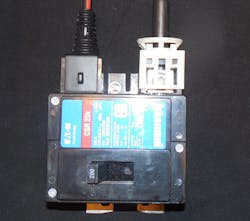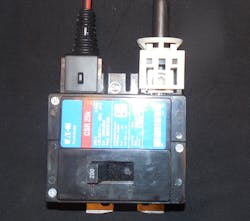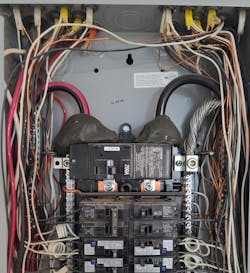Practically Speaking: Breaking Down “Barriers”
Photo 1 shows two examples of protective barriers permitted to be installed on the supply-side terminals of a circuit breaker used as a service disconnect. Photo 2 shows duct seal covering the supply-side terminals. A question was recently asked by Willy Geezer, a member in the more than 46,000-member Electrical Code Discussion group of Facebook as to whether duct seal could be used to cover the supply-side terminals to comply with Sec. 230.62(C) barrier requirements. When I first read Willy’s question, I instinctively wanted to say, “No way!” But when I read the wording in Sec. 230.62(C) again, I had second thoughts.
Product standards for panelboards allow certain barriers to be metal, nonmetallic, or even slate or marble. Product standards for enclosed switches also permit barriers to be metal, nonmetallic, and vulcanized fiber. Field-installable barrier kits are also available for panelboards and enclosed switches. Barriers that are installed as part of a panelboard, enclosed switch, or other service equipment or barriers installed as a field installable accessory kit for any of this equipment would be subjected to passing stringent product standard testing criteria. There are many kinds of duct seal, but I’m not sure which product standards, if any, these sealants would be classified under. While using duct seal as a barrier to satisfy Sec. 230.62(C) may not be specifically permitted, it is also not specifically prohibited either. This leads me to some other questions, too. Would silicone sealant be OK? Would simply covering the terminals with rubber tape be OK? Would PVC tape be OK? I suppose installers would want to have a discussion with the AHJ prior to choosing duct seal or any of these other “creative” ideas as the method of providing the required barrier.
If I was the AHJ and saw duct seal covering the energized supply-side terminals, I would need some assurances that the duct seal will be able to perform as effectively as a barrier that is specifically designed by the manufacturer for this application. Section 230.62(C) does not presently require these barriers to be identified or listed, but a discussion with the AHJ would be a good idea to determine what barriers he or she might approve.
Thanks for the great question, Willy! A big thank you also goes to Tyrus James, owner of James Family Electric in Northfield, N.H., for sharing the photo of the duct seal installation he discovered while performing some work at a customer’s property.
About the Author

Russ LeBlanc
Owner
Russ started in the electrical trade as an apprentice in 1985. He worked his way up to become a Journeyman Electrician and then eventually became a Master Electrician and Licensed Construction Supervisor. In 1999 Russ become an Electrical Instructor for The Peterson School of Engineering in Massachusetts where he developed his passion for teaching, and quickly became Department Head of Electrical Instruction. Russ has taught thousands of apprentices, electricians, engineers, inspectors, and other electrical professionals during his career as an instructor. He continues to provide electrical professionals with Electrical Code seminars, Arc-Flash Awareness training seminars and educational material through his LeBlanc Consulting Services in North Reading, MA whose specialty is educating electricians. He has been an active member of the NFPA Electrical Section and has authored hundreds of National Electrical Code proposals and comments which have become Code rules to improve the safety for the electrical industry. Russ is also an IAEI certified Electrical Inspector.
Please visit www.russleblanc.net for more information.


